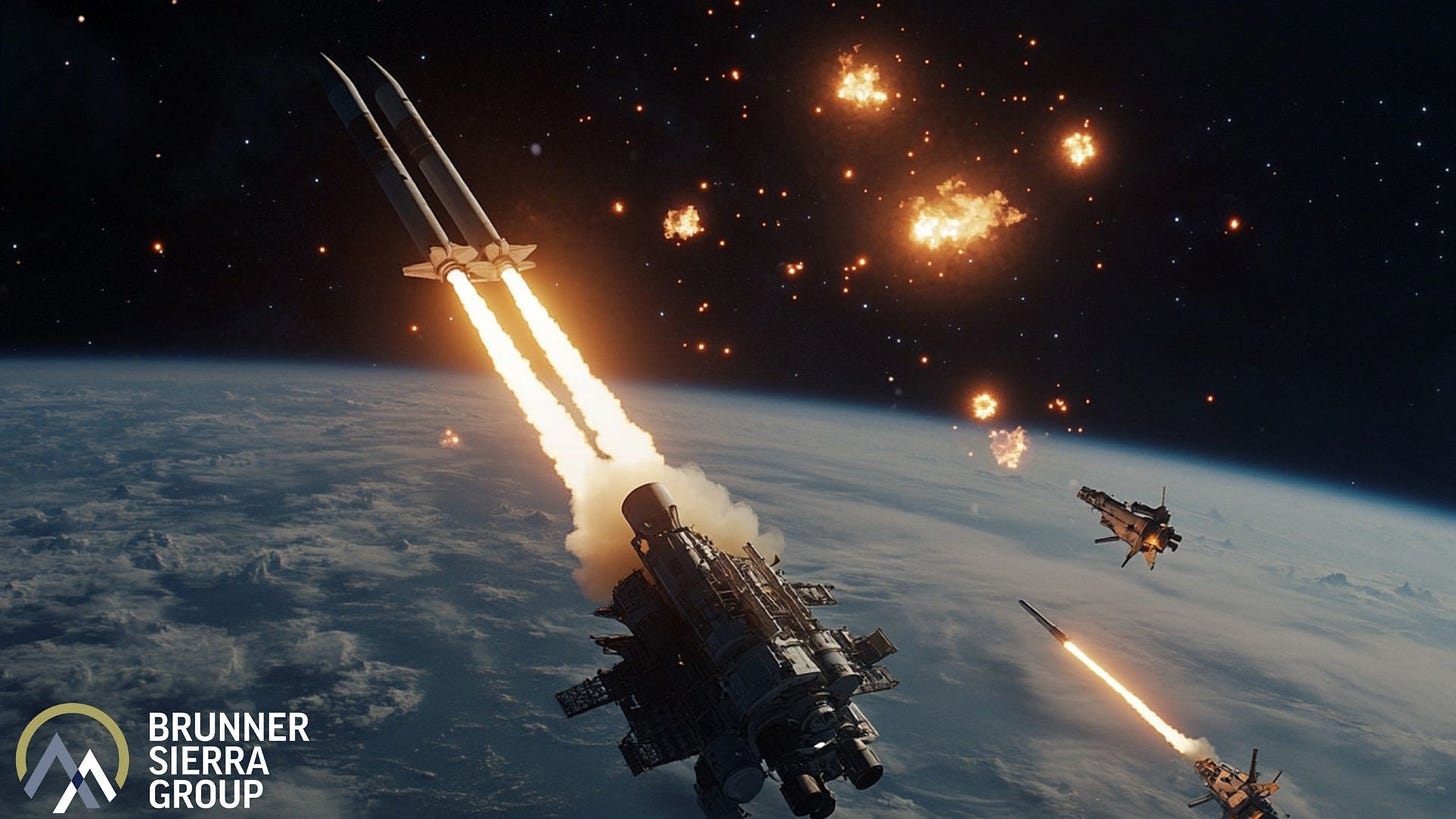Space Supremacy: The New Battleground Among Global Powers
How the Militarization of Orbit Signals a New Era of Global Power Struggles
By Daniel Brunner | Brunner Sierra Group | Chief Operating Officer
Space: The Next Battlefield
The militarization of space is no longer a theoretical concern but a tangible reality. Nations are actively developing and deploying technologies that could transform space into a contested warfighting domain. The United States, for instance, has established the U.S. Space Force, focusing on preparing for potential conflicts in space and monitoring threats from advanced weaponry developed by adversaries like China and Russia. China’s rapid expansion in space capabilities includes the development of anti-satellite (ASAT) weapons and experimental satellites capable of complex maneuvers, raising concerns about potential offensive operations in orbit. Russia, too, has been active, with reports of satellites like Cosmos 2553 being linked to programs aimed at developing nuclear anti-satellite weapons, challenging existing international treaties. These developments signify a shift from space as a peaceful domain to one where military strategies are increasingly being projected.
The Global Race for Space Supremacy
The strategic importance of space has led to a global race among nations to establish dominance in this new frontier. China has invested heavily in its space industry, developing advanced space weapons, including high-powered microwave devices capable of disrupting various space-based systems. The U.S. has responded by enhancing its own space capabilities and sharing sensitive intelligence on Chinese and Russian space operations with allies, aiming to strengthen collective security.
Russia’s activities, such as deploying satellites with potential offensive capabilities, have further intensified this race. These actions underscore the urgency for nations to secure their assets in space and prepare for potential conflicts that could have far-reaching implications for global security and the functioning of critical infrastructure reliant on space-based systems.
Technological Advancements and Strategic Implications
Advancements in technology have significantly altered the strategic landscape of space. Nations are developing sophisticated systems, including directed-energy weapons, satellite jammers, and maneuverable satellites capable of offensive operations. The integration of artificial intelligence and machine learning into these systems enhances their capabilities, allowing for more precise targeting and rapid decision-making. However, these advancements also raise concerns about the potential for accidental conflicts and the escalation of tensions.
The dual-use nature of many space technologies complicates efforts to distinguish between civilian and military applications, making it challenging to establish clear norms and regulations. As nations continue to develop and deploy these technologies, the risk of misinterpretation and unintended consequences increases, emphasizing the need for comprehensive strategies to manage the militarization of space.
International Efforts and Legal Challenges
The international community has recognized the need to address the militarization of space, but efforts to establish binding legal frameworks have faced significant challenges. The 1967 Outer Space Treaty, which prohibits the placement of nuclear weapons in space, remains a cornerstone of space law. However, its provisions are limited in addressing the complexities of modern space activities.
Proposals like the Prevention of an Arms Race in Outer Space (PAROS) treaty aim to build upon existing agreements, but consensus among major spacefaring nations has been elusive. Disagreements over definitions, verification mechanisms, and enforcement have hindered progress. Without robust legal frameworks, the risk of an arms race in space increases, potentially leading to destabilization and conflict.
Strategic Alliances and Collective Security
In response to the growing militarization of space, nations are forming strategic alliances to enhance collective security. The United States has initiated efforts to share intelligence and coordinate space operations with allies, aiming to deter adversarial actions and protect shared interests. Proposals for alliances like the “Artemis Alliance” seek to formalize these collaborations, providing a platform for joint decision-making and response strategies.
Such alliances can serve as a deterrent, signaling a unified stance against the weaponization of space. However, they also risk escalating tensions, as rival nations may perceive them as threats to their own security. Balancing the benefits of collective security with the potential for increased competition remains a critical challenge in the evolving dynamics of space geopolitics.
The Path Forward: Balancing Security and Peace
As space becomes increasingly integral to national security and economic prosperity, the imperative to prevent its militarization grows. Establishing clear norms, enhancing transparency, and fostering international cooperation are essential steps toward ensuring space remains a domain of peace.
Engaging in dialogue, building trust among nations, and developing verification mechanisms can help mitigate the risks associated with the deployment of space weapons. Investing in resilience and redundancy for space-based systems can also reduce vulnerabilities. Ultimately, the choices made today will shape the future of space exploration and utilization, determining whether it becomes a theater of conflict or a realm of collaboration and innovation.






